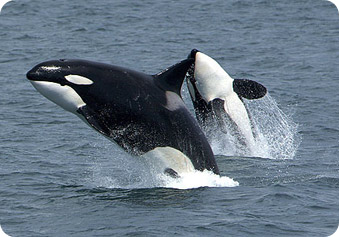In aquariums and water shows, the Orca looks cute and cuddly. Its streamlined shape, black-and-white coloring, and strong leaps make it a popular performer. But in the wild, it earns its nickname: killer whale. It hunts in packs, and eats just about anything that swims or floats. And it doesn’t matter how big the prey is -- Orcas will attack whales that are many times their own size.
 Orcas are the largest of all dolphins. Credit: National Oceanic & Atmospheric Administration
Orcas are the largest of all dolphins. Credit: National Oceanic & Atmospheric Administration Even so, Orcas are among the most civilized of all marine creatures. They live in “pods” of a few to a few dozen animals. Some pods consist entirely of family members -- up to several generations that stick together as a group. Others are more “transient” groups, with unrelated members joining and leaving the pod at will.
Orcas communicate with sound, and each pod has its own unique dialect. And like dolphins, they also use sound for hunting and navigation. In fact, Orcas are dolphins -- the largest of them all.
Orcas help raise and train each other’s youngsters, and they work together to herd prey toward the pod. And while they prefer fish, they also eat seals, sea lions, and other whales and dolphins -- even other Orcas. They sometimes flop onto the shore or drifting slabs of ice to nab a careless mammal or bird that lingered too near the water. It’s this aggressiveness and appetite that earned the “killer-whale” nickname.
The one thing Orcas don’t hunt is people. They may lighten your wallet, but otherwise these graceful killers are no threat.

